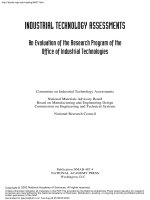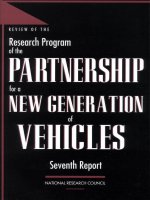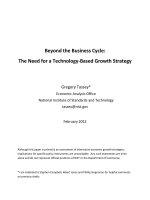Research Program of the Partnership for a New Generation of Vehicles doc
Bạn đang xem bản rút gọn của tài liệu. Xem và tải ngay bản đầy đủ của tài liệu tại đây (1.33 MB, 134 trang )
Standing Committee to Review the Research Program of the
Partnership for a New Generation of Vehicles
Board on Energy and Environmental Systems
Division on Engineering and Physical Sciences
Transportation Research Board
National Research Council
NATIONAL ACADEMY PRESS
Washington, D.C.
for a
of
Research Program
of the
REVIEW OF THE
Seventh Report
National Academy Press • 2101 Constitution Avenue, N.W. • Washington, DC 20418
NOTICE: The project that is the subject of this report was approved by the Governing Board of the
National Research Council, whose members are drawn from the councils of the National Academy of
Sciences, the National Academy of Engineering, and the Institute of Medicine. The members of the
committee responsible for the report were chosen for their special competences and with regard for
appropriate balance.
This report and the study on which it is based were supported by Contract No. DTNH22-00-G-07519.
Any opinions, findings, conclusions, or recommendations expressed in this publication are those of
the author(s) and do not necessarily reflect the views of the organizations or agencies that provided
support for the project.
Library of Congress Control Number: 2001094462
International Standard Book Number 0-309-07603-X
Available in limited supply from: Additional copies are available for sale from:
Board on Energy and Environmental Systems National Academy Press
National Research Council 2101 Constitution Avenue, N.W.
2101 Constitution Avenue, N.W. Box 285
HA-270 Washington, DC 20055
Washington, DC 20418 800-624-6242 or 202-334-3313 (in the Washington
202-334-3344 metropolitan area)
Copyright 2001 by the National Academy of Sciences. All rights reserved.
Printed in the United States of America
The National Academy of Sciences is a private, nonprofit, self-perpetuating society of
distinguished scholars engaged in scientific and engineering research, dedicated to the
furtherance of science and technology and to their use for the general welfare. Upon the
authority of the charter granted to it by the Congress in 1863, the Academy has a mandate
that requires it to advise the federal government on scientific and technical matters.
Dr. Bruce M. Alberts is president of the National Academy of Sciences.
The National Academy of Engineering was established in 1964, under the charter of the
National Academy of Sciences, as a parallel organization of outstanding engineers. It is
autonomous in its administration and in the selection of its members, sharing with the
National Academy of Sciences the responsibility for advising the federal government.
The National Academy of Engineering also sponsors engineering programs aimed at
meeting national needs, encourages education and research, and recognizes the superior
achievements of engineers. Dr. Wm. A. Wulf is president of the National Academy of
Engineering.
The Institute of Medicine was established in 1970 by the National Academy of Sciences
to secure the services of eminent members of appropriate professions in the examination
of policy matters pertaining to the health of the public. The Institute acts under the
responsibility given to the National Academy of Sciences by its congressional charter to
be an adviser to the federal government and, upon its own initiative, to identify issues of
medical care, research, and education. Dr. Kenneth I. Shine is president of the Institute of
Medicine.
The National Research Council was organized by the National Academy of Sciences in
1916 to associate the broad community of science and technology with the Academy’s
purposes of furthering knowledge and advising the federal government. Functioning in
accordance with general policies determined by the Academy, the Council has become the
principal operating agency of both the National Academy of Sciences and the National
Academy of Engineering in providing services to the government, the public, and the
scientific and engineering communities. The Council is administered jointly by both
Academies and the Institute of Medicine. Dr. Bruce M. Alberts and Dr. Wm. A. Wulf are
chairman and vice chairman, respectively, of the National Research Council.
National Academy of Sciences
National Academy of Engineering
Institute of Medicine
National Research Council
STANDING COMMITTEE TO REVIEW THE RESEARCH PROGRAM
OF THE PARTNERSHIP FOR A NEW GENERATION OF VEHICLES
CRAIG MARKS (Chair), NAE,
1
AlliedSignal (retired), Bloomfield Hills,
Michigan
VERNON P. ROAN (Vice Chair), University of Florida, Gainesville
WILLIAM AGNEW, NAE, General Motors Research Laboratories (retired),
Washington, Michigan
KENNERLY H. DIGGES, George Washington University, Washington, D.C.
W. ROBERT EPPERLY, Epperly Associates, Mountain View, California
DAVID E. FOSTER, University of Wisconsin, Madison
NORMAN A. GJOSTEIN, NAE, University of Michigan, Dearborn
DAVID F. HAGEN, Ford Motor Company (retired), Dearborn, Michigan
JOHN B. HEYWOOD, NAE, Massachusetts Institute of Technology, Cambridge
FRITZ KALHAMMER, Electric Power Research Institute (retired), Palo Alto,
California
JOHN G. KASSAKIAN, NAE, Massachusetts Institute of Technology,
Cambridge
HAROLD H. KUNG, Northwestern University, Evanston, Illinois
DAVID F. MERRION, Detroit Diesel Corporation (retired), Brighton, Michigan
JOHN SCOTT NEWMAN, NAE, University of California, Berkeley
ROBERTA NICHOLS, NAE, Ford Motor Company (retired), Plymouth,
Michigan
F. STAN SETTLES, NAE, University of Southern California, Los Angeles
Committee Subgroup on Systems Analysis and
Electrical and Electronic Systems
JOHN G. KASSAKIAN (Chair)
JOHN B. HEYWOOD
JOHN SCOTT NEWMAN
ROBERTA NICHOLS
F. STAN SETTLES
Committee Subgroup on Batteries
FRITZ KALHAMMER (Chair)
HAROLD H. KUNG
JOHN SCOTT NEWMAN
VERNON P. ROAN
v
1
NAE = National Academy of Engineering
vi
Committee Subgroup on Fuels
W. ROBERT EPPERLY (Chair)
DAVID E. FOSTER
DAVID F. MERRION
ROBERTA NICHOLS
Committee Subgroup on Fuel Cells
VERNON P. ROAN (Chair)
FRITZ KALHAMMER
HAROLD H. KUNG
JOHN SCOTT NEWMAN
Committee Subgroup on Internal Combustion Engines and Emissions Control
DAVID E. FOSTER (Chair)
WILLIAM AGNEW
W. ROBERT EPPERLY
DAVID F. HAGEN
JOHN B. HEYWOOD
DAVID F. MERRION
Committee Subgroup on Materials and Safety
NORMAN A. GJOSTEIN (Chair)
KENNERLY H. DIGGES
DAVID F. HAGEN
F. STAN SETTLES
Committee Subgroup on Cost Analysis
CRAIG MARKS (Chair)
WILLIAM AGNEW
DAVID F. HAGEN
DAVID F. MERRION
F. STAN SETTLES
vii
Project Staff
JAMES ZUCCHETTO, Responsible Staff Officer, Board on Energy and
Environmental Systems (BEES)
NAN HUMPHREY, Senior Program Officer, Transportation Research Board
SUSANNA E. CLARENDON, Senior Project Assistant and Financial
Associate (BEES)
viii
BOARD ON ENERGY AND ENVIRONMENTAL SYSTEMS
ROBERT L. HIRSCH (Chair), RAND, Arlington, Virginia
RICHARD E. BALZHISER, NAE,
1
Electric Power Research Institute, Inc.
(retired), Menlo Park, California
DAVID L. BODDE, University of Missouri, Kansas City
PHILIP R. CLARK, NAE, GPU Nuclear Corporation (retired), Boonton,
New Jersey
WILLIAM L. FISHER, NAE, University of Texas, Austin
CHRISTOPHER FLAVIN, Worldwatch Institute, Washington, D.C.
HAROLD FORSEN, NAE, Foreign Secretary, National Academy of
Engineering, Washington, D.C.
WILLIAM FULKERSON, Oak Ridge National Laboratory (retired) and
University of Tennessee, Knoxville
MARTHA A. KREBS, California Nanosystems Institute, Los Angeles, California
GERALD L. KULCINSKI, NAE, University of Wisconsin, Madison
EDWARD S. RUBIN, Carnegie Mellon University, Pittsburgh, Pennsylvania
ROBERT W. SHAW JR., Aretê Corporation, Center Harbor, New Hampshire
JACK SIEGEL, Energy Resources International, Inc., Washington, D.C.
ROBERT SOCOLOW, Princeton University, Princeton, New Jersey
KATHLEEN C. TAYLOR, NAE, General Motors Corporation, Warren,
Michigan
JACK WHITE, Association of State Energy Research and Technology Transfer
Institutions, Falls Church, Virginia
JOHN J. WISE, NAE, Mobil Research and Development Corporation (retired),
Princeton, New Jersey
Staff
JAMES ZUCCHETTO, Director
RICHARD CAMPBELL, Program Officer
ALAN CRANE, Program Officer
MARTIN OFFUTT, Program Officer
SUSANNA CLARENDON, Financial Associate
PANOLA GOLSON, Project Assistant
ANA-MARIA IGNAT, Project Assistant
SHANNA LIBERMAN, Project Assistant
1
NAE = National Academy of Engineering
ix
Acknowledgments
The committee wishes to thank all of the members of the Partnership for a
New Generation of Vehicles, who contributed a significant amount of their time
and effort to this National Research Council (NRC) study by giving presentations
at meetings, responding to requests for information, or hosting site visits. The
committee also acknowledges the valuable contributions of other organizations
that provided information on advanced vehicle technologies and development
initiatives. Finally, the chair wishes to recognize the committee members and the
staff of the NRC Board on Energy and Environmental Systems for their hard
work in organizing and planning committee meetings and their individual efforts
in gathering information and writing sections of the report.
This report has been reviewed by individuals chosen for their diverse per-
spectives and technical expertise, in accordance with procedures approved by the
NRC’s Report Review Committee. The purpose of this independent review is to
provide candid and critical comments that will assist the authors and the NRC in
making the published report as sound as possible and to ensure that the report
meets institutional standards for objectivity, evidence, and responsiveness to the
study charge. The content of the review comments and draft manuscript remain
confidential to protect the integrity of the deliberative process. We wish to thank
the following individuals for their participation in the review of this report:
Charles Amann (NAE), Gary L. Borman (NAE), Pat Flynn (NAE), Robert A.
Frosch (NAE), Harvard University, Roger McClellan (IOM), Jerome G. Rivard
(NAE), Global Technology and Business Development, Dale F. Stein (NAE),
R. Rhoads Stephenson, and Supramaniam Srinivasan, Princeton University.
x ACKNOWLEDGMENTS
Although the reviewers listed above have provided many constructive com-
ments and suggestions, they were not asked to endorse the conclusions and
recommendations, nor did they see the final draft of the report before its release.
The review of this report was overseen by Trevor Jones, Biomec, Inc., appointed
by the NRC’s Division on Engineering and Physical Sciences, and Gary Byrd,
consulting engineer, appointed by the Report Review Committee, who were
responsible for making certain that an independent examination of the report was
carried out in accordance with institutional procedures and that all review com-
ments were carefully considered. Responsibility for the final content of this report
rests entirely with the authoring committee and the institution.
xi
Contents
EXECUTIVE SUMMARY 1
1 INTRODUCTION 13
Program Progress, 16
The Evolving Context, 17
Scope of Review, 18
2 DEVELOPMENT OF VEHICLE SUBSYSTEMS 20
Candidate Systems, 20
Internal Combustion Reciprocating Engines, 22
Fuel Cells, 37
Electrochemical Energy Storage, 43
Power Electronics and Electrical Systems, 50
Structural Materials, 55
Vehicle Safety, 63
Fuel Issues, 66
3 VEHICLE ENGINEERING DEVELOPMENTS 71
Systems Analysis, 71
Hybrid Production Vehicles, 72
Concept Cars and Production Prototypes, 76
xii CONTENTS
4 PROGRAM OVERVIEW 78
The Changing Context, 78
Program Perspectives, 79
Summary, 82
5 PNGV’s RESPONSE TO THE SIXTH REPORT 84
REFERENCES 86
APPENDIXES
A Biographical Sketches of Committee Members 93
B The PNGV Response to Recommendations in the Sixth Report 100
C Presentations and Committee Activities 111
D United States Council for Automotive Research Consortia 114
ACRONYMS AND ABBREVIATIONS 115
xiii
Tables and Figures
TABLES
2-1 CIDI Engine Technology R&D Plan Technical Targets for an 80-mpg
PNGV Vehicle, 25
2-2 Fuel Properties of Ad Hoc Fuel Test Program, 33
2-3 Engine Operating Conditions of Ad Hoc Fuel Test Program, 34
2-4 Proposed Revised Technical Targets for Integrated Fuel Cell Power
Systems, 44
2-5 New Targets for Batteries, 46
2-6 Current Status and Targets for Power Electronics and Motors, 51
2-7 New Target Specifications for Two System Sizes for the AEMD, 52
2-8 Weight-Reduction Targets for the Goal 3 Vehicle, 55
2-9 Selected Attributes of PNGV 2000 Concept Vehicles, 56
2-10 Weight Savings for Lightweight Materials, 56
FIGURES
2-1 Lightweight materials: affordability influences, 58
2-2 Polymer composite pickup box, 60
2-3 Cost of polymer composite pickup box relative to the cost of steel
pickup box, 60
2-4 The ACC Focal Project III body-in-white structure, 61
3-1 Honda Insight power-train configuration, 73
3-2 Toyota Prius power-train configuration, 74
for a
of
Research Program
of the
REVIEW OF THE
Seventh Report
1
Executive Summary
This is the seventh report by the National Research Council Standing Com-
mittee to Review the Research Program of the Partnership for a New Generation
of Vehicles (PNGV). The PNGV program is a cooperative research and develop-
ment (R&D) program between the federal government and the United States
Council for Automotive Research (USCAR), whose members are DaimlerChrysler
Corporation, Ford Motor Company, and General Motors Corporation (GM). The
program addresses improvements in national competitiveness in manufacturing
and in the implementation of energy-saving innovations in passenger vehicles. In
addition, it seeks to develop a new generation of vehicles by setting a stretch goal
to achieve fuel economy up to three times (80 miles per gallon [mpg] gasoline
equivalent) that of comparable 1994 family sedans without sacrificing size or
utility or increasing the cost of ownership. The purpose of this program is to
conceive, develop, and implement new technologies capable of significantly
reducing the petroleum consumption and carbon dioxide emissions of the U.S.
automobile fleet. The founders recognized that, to have substantial impact, this
new generation of vehicles must be sold in high volume. This, in turn, requires
that the vehicles meet or exceed all emission and safety requirements and offer all
of the characteristics that result in strong customer appeal.
This report contains the committee’s assessment of the overall balance and
adequacy of the PNGV research program to meet its technical goals and the
program’s efforts to develop commercially feasible low-emission propulsion sys-
tems. The committee also comments on significant changes that have occurred
since the inception of the PNGV program and how these changes might influence
this program.
2 PARTNERSHIP FOR A NEW GENERATION OF VEHICLES
PROGRESS AND MAJOR ACHIEVEMENTS
The PNGV program has overcome many challenges and has forged a useful
and productive partnership of industry and government participants. In addition
to the cooperative program, substantial proprietary industry R&D activity has
been generated. Teams of industry and government representatives have ad-
dressed formidable technical issues and made significant progress on many of
them despite the complexity of managing an inter-disciplinary program involving
three competing companies, several government agencies, and significant gov-
ernment budget constraints. The program concept cars introduced in January and
February of 2000 are important evidence of these activities, but the ongoing R&D
program, much of which is summarized in the following sections, is equally
significant.
The following summarizes activities for meeting goals 1, 2, and 3 of the
program.
Goal 1
The manufacturing competitiveness goal, Goal 1, addresses the need to
develop improved manufacturing processes for conventional vehicles, as well as
the new-generation vehicles and their components. A wide array of manufactur-
ing issues has been addressed in the cooperative program. Projects to reduce the
cost and improve the quality of aluminum structures, drill holes more rapidly, and
improve leak testing were completed in 2000-2001. Several projects to facilitate
the manufacture of lower-cost, lighter-weight vehicle bodies have been proposed
for funding in fiscal year 2002. Manufacturing considerations are being addressed
for many of the new components that will be required by the radically different
hybrid-electric-vehicle power trains being developed. Also, several longer-term
and higher-risk manufacturing projects are at the proposal stage.
Since a large proportion of the components needed to assemble automobiles
comes from suppliers, the need for manufacturing improvements extends well
beyond the automobile manufacturers themselves. Suppliers are already involved
in some PNGV activities, but the PNGV manufacturing program would benefit
from expansion of these supplier activities.
Goal 2
The purpose of Goal 2 is to speed the introduction of new technology
generated by PNGV R&D into production vehicles. Several manufacturing and
engineering analysis tools developed by the program are in use, and significant
applications of lightweight materials have been introduced in production vehicles.
The most striking Goal 2 achievement is the announced plans by all three
automobile companies to introduce hybrid power trains during the next two to
three years in both pickup trucks and sport utility vehicles in a variety of configu-
EXECUTIVE SUMMARY 3
rations. The reduction in fuel consumption will range from 10 to 30 percent,
twice the amount that would be saved if the same percentage reduction were
obtained by applying hybrid technology to a mid-size car that initially had two
times the fuel economy (mpg) of these trucks. The committee commends the
automobile companies for this commitment to produce vehicles that will signifi-
cantly reduce the total fuel consumption of the light-duty vehicle fleet even with
an increase in sales.
Goal 3
Goal 3 has provided an extremely challenging focus for the program: to
develop within 10 years (by 2004) vehicles that will achieve up to three times the
fuel efficiency of comparable 1994 family sedans while retaining the features that
make them marketable and affordable. The year 2000 concept-vehicle milestone
was met when the three manufacturers each introduced concept cars: the
DaimlerChrysler ESX3, the Ford Prodigy, and the General Motors Precept, as
detailed in the last committee report. All three concept vehicles incorporate
hybrid-electric power trains designed around small, turbocharged, compression-
ignition direct-injection (CIDI) engines, using diesel fuel, which shut down when
the vehicles come to rest. All employed the significant technical advances devel-
oped in the PNGV program to reduce the energy requirements for propelling the
vehicle (e.g., reduced mass, aerodynamic drag) and for supplying auxiliary loads
(e.g., heating, air conditioning). Each company took a different approach to the
design of these cars, which resulted in different remaining challenges to meet the
fuel economy and affordability targets, but all of the cars operate on diesel fuel.
These cars provide a valuable measure of how challenging it will be to meet all
the components of Goal 3 simultaneously.
The next major Goal 3 milestone of the PNGV program as currently struc-
tured is the development of production-prototype cars by 2004. Each car com-
pany is in the planning stage for this activity, and the approach that each may take
is not clear. Validation of production readiness for a new car requires immense
resources compared to the preceding R&D activities. For these resources to be
justified, the car must be one that is included in the production plans of each
manufacturer, plans that are, of course, proprietary. In order for the committee to
evaluate the PNGV program in context, each year the car companies have shared
proprietary information with the committee. As work progresses toward produc-
tion prototypes, more of it becomes proprietary and this limits the detail about
Goal 3 activity that can be reported by the committee in this and future reports.
Vehicle Engineering, Structural Materials, and Safety
The PNGV concept vehicles made public last year all made extensive use of
lightweight materials and new body construction techniques to achieve major
4 PARTNERSHIP FOR A NEW GENERATION OF VEHICLES
reductions (20 to 31 percent) in curb weight. The high cost of these lightweight
materials and the associated manufacturing costs represent a significant part of
the affordability challenge faced by the program. More than 30 materials projects
have been established to attack the technical challenges identified. In addition,
the car companies each have proprietary programs, and the American Iron and
Steel Institute has embarked on a second-phase advanced vehicle concept car
aimed at identifying affordable ways to reduce weight.
As progress is made on these projects the benefits of lighter-weight construc-
tion will be achieved in production vehicles. The PNGV program has developed
lower-cost, lightweight-material production processes such as continuous casting
of aluminum sheet, powder-metal processes for aluminum-metal matrix compos-
ites, and a microwave process for producing carbon fiber. Vehicle production
programs using these materials probably will be necessary to provide material
suppliers with the incentive to invest in these new processes.
The newly formed PNGV Safety Working Group is addressing safety issues
that have been raised by the concept-car designs. The crashworthiness of lighter-
weight vehicles in car-to-car accidents is an issue being studied. While the stated
goal is to meet present and future Federal Motor Vehicle Safety Standards, it is
recognized that these are minimum standards. The purpose of the Safety Working
Group is to identify and sponsor research directed at the unique safety character-
istics of PNGV vehicles in order to help ensure the marketability of vehicles
employing these new technologies.
Four-Stroke Direct-Injection Engines and Fuels
The CIDI engine operating on diesel fuel, chosen for its high efficiency,
continues to be the major focus of PNGV power-plant development for near-term
application. Current PNGV activity centers on the challenge of meeting new
emission standards and is being pursued in engine combustion, exhaust-gas after-
treatment, and fuels development programs. Aggressive emission reduction tar-
gets have been set for the program to meet through the year 2007. As noted in last
year’s report (NRC 2000), these emission targets, driven by the newly promul-
gated Tier 2 emission standards, are now much more stringent than they were at
the outset of the PNGV program.
In the combustion program, diagnostic techniques for measuring cylinder-to-
cylinder distribution of recirculated exhaust gas (a key NO
x
control measure) and
for in-cylinder measurement of particulate particle size and number have made
progress this year. Advanced simulation techniques have also been developed
and validated, with the promise of these techniques becoming useful as an opti-
mizing tool for engine design.
NO
x
exhaust-gas after-treatment is being pursued using lean-NO
x
absorber
catalysts, selective catalytic reduction systems using urea, and nonthermal plasma
catalytic systems. Development is in an early stage, and all systems result in a
EXECUTIVE SUMMARY 5
fuel economy penalty, some estimated as low as 0.5 percent and others as high as
8 percent. Nitrogen oxide traps also are being tested with the current conclusion
that, because of extreme sensitivity to sulfur poisoning, they may require simul-
taneous use of a sulfur trap. Particulate reduction will require yet another trap and
an effective regeneration mechanism.
The engine-fuel interactions program was focused on the effects of fuel
chemistry and physical properties on engine performance and emissions. Results
to date indicate that the fuel does have an effect on engine-out particulate and
NO
x
emissions, but that these effects are not large enough to eliminate the need
for substantial after-treatment. The sulfur level in fuels will have a significant
effect on both engine-out particulates and the performance of after-treatment
systems. Quantification of these relationships remains a priority.
Fuel Cells
Fuel cells continue to show promise of high efficiency and very low emis-
sions with continuous progress toward targets that are very difficult to meet for
any general-purpose, high-volume automotive application. There are many sub-
stantial barriers remaining to be overcome prior to the realization of a mass-
manufactured consumer vehicle. These barriers include performance as well as
physical, fuel-related, and cost issues. In the short term it appears that some
limited-production fleet vehicles will operate on pure hydrogen stored onboard
the vehicle, which results in a simpler and less expensive system for the vehicle;
however, for the foreseeable future, high-volume, general-purpose vehicles likely
will require the fuel cell system to be combined with an onboard reformer that
produces hydrogen from a liquid fuel. The efficiency of these liquid-fuel reformers
is a critical issue: Current prototype reformers significantly degrade the overall
fuel cell system efficiency.
This year a major program milestone was the demonstration of two inte-
grated gasoline-fueled 50-kW fuel cell systems. The projected size, weight, and
cost of these systems are short of the original year 2000 targets by a large margin,
but these systems represent encouraging progress and will help define the goals
for component development that will improve system performance. Significant
improvements have been demonstrated in many of the components: fuel proces-
sors, heat exchangers, catalysts, bipolar plates, and complete stacks. In addition,
large proprietary programs are under way both by the automobile companies and
potential fuel cell suppliers, and these programs are driving component improve-
ments in all of these areas.
Batteries
Research and development on batteries continues to focus on nickel metal
hydride, lithium-ion, and more recently, lithium-polymer designs. Full-scale sys-
6 PARTNERSHIP FOR A NEW GENERATION OF VEHICLES
tems employing each of these designs have demonstrated their capability to meet
the key technical performance targets for hybrid-vehicle applications during the
past year, but the battery life challenge has become even more severe. The tech-
nical team has adopted targets that correspond to a 15-year battery calendar and
operating life. The battery cost targets seem to be very aggressive. The costs of
batteries in the currently marketed Japanese hybrid vehicles exceed these PNGV
targets by a factor of five or more. These targets should be re-examined in the
context of the prospects for meeting cost targets for the other key hybrid-vehicle
subsystems.
Supporting basic research has helped define fundamental failure mecha-
nisms of lithium-ion cells and the cause of thermal runaway. New cells have
shown life improvement in elevated-temperature accelerated tests, and more real-
istic calendar life testing methods are being developed.
Power Electronics and Electrical Systems
Both the power electronics and electric motor programs are focused on reduc-
ing the cost of these components. Three contractors for the power electronics
module have each executed a detailed economic gap analysis with their suppliers
to identify ways to ensure that their cost target can be met. These analyses have
provided detailed plans for material, labor, and overhead cost reductions, and
these plans provide reasonable confidence that the goals can be met. One of the
electric motor contractors is pursuing an axial gap permanent-magnet motor
design, and the other is using a more conventional radial gap induction machine.
Research programs at the national laboratories and at universities continue to
develop promising technologies for essential electronic and motor materials and
components. These include silicon-carbide-power semiconductors, carbon-foam
thermal materials, high-energy magnets, and low-cost, high-dielectric-constant
materials for capacitors.
MAJOR BARRIERS
As noted, significant progress continues to be made by the research being
performed in the PNGV partnership and in the many proprietary programs being
carried out by the individual partners in USCAR. Nevertheless, the committee
believes it is unlikely that all of the elements of Goal 3, including three-times fuel
economy, will be met in production-prototype vehicles in 2004. While the bulk of
the requirements (e.g., performance, comfort, cargo space, utility, and safety) can
be met, the combination of 80 mpg and affordability appears out of reach. In
addition, the recently promulgated Environmental Protection Agency (EPA) Tier
2 emission requirements will require radically better emission control technol-
ogy. It also appears that the required after-treatment devices may significantly
degrade the efficiency of the CIDI engine and increase its cost. Fuel issues also
EXECUTIVE SUMMARY 7
pose significant questions that affect the viability of widespread automobile use
of the CIDI engine and, longer term, of fuel cells, which require a supply of
hydrogen or a fuel that can be converted to hydrogen.
Cost Challenge
High prospective cost is a serious problem in almost every area of the PNGV
program. Lightweight body construction, CIDI engines, batteries, and electronic
control systems all represent increases in vehicle cost. Needed emission exhaust-
gas after-treatment devices are not well defined at this point, but they will most
certainly be more expensive than systems currently employed. The major effort
to date has been to achieve the technical targets for these components, and the
concept cars demonstrate the significant progress made; however, none of these
cars in their present forms represents an affordable set of components compatible
with similar mission vehicles.
Cost targets have always been in place for the major components, but it has
not been clear to the committee that even if these targets were achieved an
affordable vehicle would result. This year a new cost-modeling effort has been
started to address this vital subject. The plan is to develop a tool that will help the
technical teams direct their pre-competitive R&D efforts and help suppliers find
ways to reduce the gap between current costs and those needed to get to produc-
tion feasibility. The committee compliments the PNGV for getting this effort
under way.
As noted earlier, affordability is the linchpin of the PNGV program. For the
benefits PNGV intended to be realized, the economics must favor large-scale
purchases of these vehicles.
Exhaust Emissions Trade-off
The last committee report (NRC, 2000) noted that the Tier 2 NO
x
and par-
ticulate matter (PM) emission standards could preclude the early introduction and
widespread use in the United States of CIDI engines for passenger cars. Without
the CIDI engine the fuel economy of near-term PNGV cars could drop by as
much as 25 percent, the approximate difference in fuel economy between a CIDI
and a homogeneous-charge, spark-ignition engine. Although, as detailed later in
this report, significant progress is being made in developing exhaust after-treatment
systems for CIDI engines, these devices make this power plant less attractive by
increasing its fuel consumption and cost. Alternative power plants that can meet
the Tier 2 emission standards will, in all likelihood, have substantially higher fuel
consumption and carbon dioxide emissions. This raises the obvious policy ques-
tion of the relative importance to the nation of decreasing fuel consumption and
carbon dioxide emissions compared with the need to tighten the NO
x
and PM
standards at this time. This trade-off was noted in the last committee report, but
8 PARTNERSHIP FOR A NEW GENERATION OF VEHICLES
the committee is unaware of any subsequent substantive discussion of the issue.
Its resolution has obvious implications for the PNGV production-prototype plan-
ning process that is now under way.
Fuel Issues
Historically, major improvements in automobile power-plant efficiency and
exhaust emissions have required changes in the fuels they use. Notable examples
are the high-octane fuel that was required by high-compression-ratio engines and
the unleaded fuel required by catalytic converters. Both the CIDI engine and fuel
cells being considered by the PNGV are no exception. Successful introduction of
either new power plant will be critically dependent on widespread availability of
suitable fuels.
The large capital expenditures and long lead time required to manufacture
and distribute a significantly modified fuel means that the petroleum industry
must be fully aware of the needs well in advance of the production of the first
automobile that requires such a fuel. Furthermore, the change must make eco-
nomic sense for the petroleum companies or be mandated by regulation. In early
2001, the EPA published a regulation requiring refiners to produce highway
diesel fuel with a maximum sulfur content of 15 ppm by June 1, 2006 (Federal
Register, 2001). This regulation gives the PNGV CIDI development program the
challenge of finding an exhaust after-treatment system that will perform and
endure with such a fuel, since it is unlikely that fuel with any lower sulfur level
will be available in this time frame.
Automotive fuel cell power plants present a much more complicated problem
because of the early development stage of these systems. The most efficient and
lowest-emission system involves direct hydrogen storage on the vehicle, which
requires major infrastructure changes by the energy industry. With a reformer
onboard the car, a liquid fuel can be used, and it is hoped that one similar to
gasoline will be satisfactory. In the long term, reformers probably will require a
fuel tailored for this application to achieve optimum efficiency and minimum
emissions.
From this discussion it is clear that a strong, objective, cooperative program
between the PNGV participants and the petroleum industry is needed to ensure
that the lack of appropriate fuels does not become a major barrier to realizing the
goals of the program. It appears that additional priority will be required to ad-
vance this goal, as there has been little apparent progress in this area since the
committee made a similar recommendation last year.
Fuel Cells
From the inception of PNGV, practical automotive fuel cell power plants
have been considered to be well beyond the 2004 time limit of the program.









